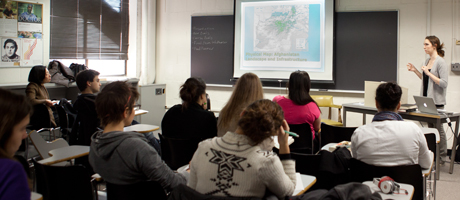All is fair in love and war.
Or is it? That’s one of the first questions Associate Professor of Religion Irene Oh asks students in her Introduction to Peace and Conflict Studies course, one of the required courses in George Washington’s new Peace Studies major.
Housed in George Washington’s Department of Religion in the Columbian College of Arts and Sciences, the program requires students to develop a “sophisticated understanding” of peace as a concept and as a practice.
“We look at peace through the lenses of religion, philosophy, history, political science and other disciplinary majors,” said Dr. Oh. “I think the students become inspired by a lot of the historical figures and movements that they come across. They also come away with an enriched vocabulary to think about conflict, peace and democracy.”
Although the program became a major in fall 2011, it was first founded decades ago by Harry Yeide, former chair of George Washington’s Department of Religion.
Students in the major take a variety of courses from departments and disciplines around the university, including history, religion, philosophy, international affairs, anthropology and sociology. Both the major and minor culminate with a capstone seminar in the students’ junior or senior year. This spring, the program will have 14 students enrolled in the capstone seminar.
The capstone, said Dr. Oh, is the “crown jewel” of the program. “Students meet weekly and design a research project or take on an internship relevant to their interests and write a short report,” she said. “There are also readings we do together as a seminar.”
Dr. Oh said the majority of students are split between Columbian College—many of whom are political science majors—and Elliott School of International Affairs students, who are attracted by the chance to view peace and conflict through a humanities angle.
In Dr. Oh’s course, students read works from historical figures, including philosophers and activists such as Immanuel Kant, Gandhi and Martin Luther King Jr. “For a lot of these students, it’s the first time they’ve had this kind of exposure to peace through these major thinkers,” she said.
Students also study current and recent conflicts around the world and present their findings to the class, as well as discuss the concept of “just war theory”—criteria about when it is morally reasonable to enter into war—and the Geneva Conventions, which govern soldiers’ behavior in war.
“I think people focus too much on how to stop wars without really thinking about what comes after,” said senior Roberto Borgert, a double major in international affairs and political science. “The Peace and Conflict Studies course offers a good perspective on how you can make a just peace and what goes into creating a situation where that can be possible.”
Dr. Oh said the assumption that the field of peace studies promotes choosing peace over war is always an interesting topic for students to debate and understand.
“The point of the Peace Studies Program is not to promote peace, it’s really to have students think very carefully about the role and place and possibilities of peace, given the large number of other factors that have to be considered, like justice,” she said.
Another major takeaway for students is that peace is actually an intellectually active process. Gandhi, for example, was a “very sophisticated and strategic thinker,” said Dr. Oh.
“His tactics in nonviolence resistance—not passive resistance—actually took a lot of education, training and strategy,” she said, “and students realize these factors are needed in order for peace movements to work effectively.”
“Oftentimes we use the phrase ‘peace building,’ because it takes active work to ensure that peace and justice happen,” she added. “You have to build a just peace. Peace is not passive.”


